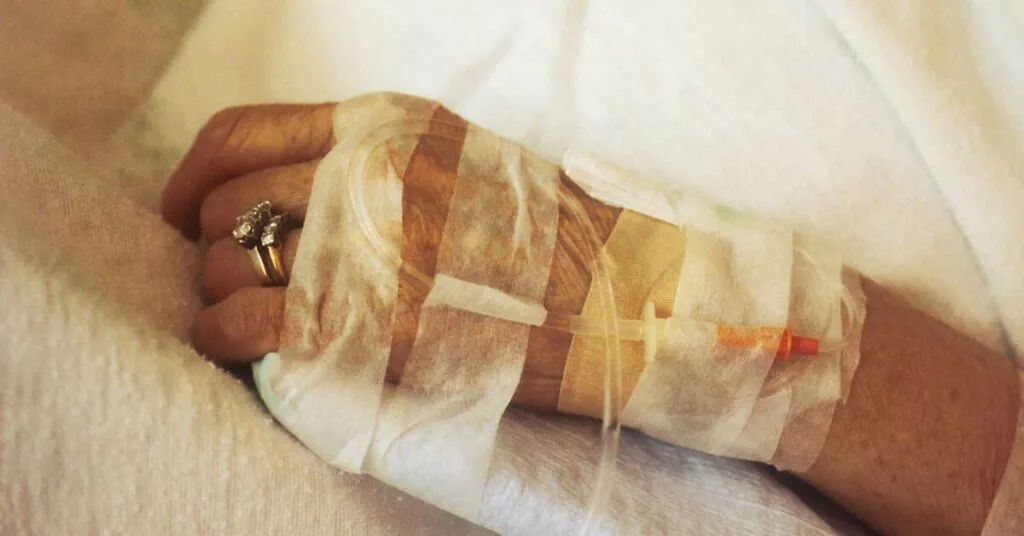Chemotherapy is perhaps the most common line of treatment recommended for cancer patients. Statistics show that nearly 25% of patients receive it every year. Over the years, advances in chemotherapy have improved patient outcomes like survival rates and life expectancy. Continued cancer research may find even better chemo drugs in the future.
However, while chemotherapy can be highly effective, it comes with certain side effects and complications. According to a study, 97.4% of the patients reported mild side effects during the follow-up phase of six months. These include loss of appetite, nausea, diarrhea, and dyspnea. The risk rises when chemo drugs are administered intravenously via intravenous (IV) infusion, even if it improves the efficacy of the treatment.
Awareness can help you be better prepared and plan a strategy to combat potential complications and risks. In this article, we will highlight the IV risks patients should be aware of before undergoing chemotherapy.
Table of Contents
Infection
Research suggests that catheter-associated bloodstream infections (CLABSI) are a severe health problem with a high prevalence. Moreover, their prevalence is high, leading to elevated economic costs and an increase in mortality. This is a cause of concern for chemotherapy patients because the insertion of an IV catheter is a part of the protocol.
While the device creates a direct pathway into the bloodstream, it also increases the risk of introducing bacteria or other pathogens. The bigger problem is that patients with compromised immune systems are vulnerable to infections. The Bard Power Port devices have been under scrutiny for causing severe infections and necrosis of tissues around the catheter.
Patients suffering due to infections and injuries caused by the devices are eligible to file a Bard Power Port lawsuit. The manufacturer is liable to compensate the victims if they can establish the link between their suffering with defective devices.
According to TorHoerman Law, 50 Bard lawsuits have been consolidated under multidistrict litigation as of September 2023. The devices were even recalled by the FDA in March 2020. While the recall was later terminated in March 2022, the concerns regarding its safety persist. Moreover, the increase in lawsuits against manufacturers underscores the gravity of the risk.
Phlebitis
Phlebitis, inflammation of the vein, is another potential complication patients may encounter during intravenous chemotherapy. In a recent study, 30.34% of patients experienced phlebitis, indicating prevalence as high as 1 among 3 patients. An older study indicated a prevalence of 70%, though the rates have decreased due to improvements in devices and techniques over the years.
Chemical irritants in chemo drugs are the primary cause of the condition as they irritate and damage the vein walls. Symptoms of phlebitis include swelling, redness, tenderness, and warmth around the vein. Providers may recommend rotating the infusion site regularly to reduce the risk of phlebitis. Using larger veins for infusion is another possible solution.
Extravasation
When a drug is administered through a venous cannula, a small risk of extravasation or leakage of the medication out of the veins into the surrounding tissue persists. It may happen in two circumstances- the IV catheter gets dislodged or the vein is damaged during insertion. The condition may also occur if the drug is administered too quickly or there is an obstruction in the IV line.
The problem is more severe with vesicant drugs used in chemotherapy because they can cause blistering and ulceration in tissues. Extravasation can result in symptoms such as pain and inflammation at the infusion site. Tissue necrosis is a more serious and long-term complication. Providers monitor IV infusions closely to detect the early signs of extravasation and take prompt measures to minimize tissue damage.
Thrombosis
Thrombosis is perhaps the most serious complication faced by patients undergoing chemotherapy. Unfortunately, patients suffering from cancer-associated thrombosis can actually die of the thrombosis itself rather than the progression of the disease. A study showed that it led to a mortality rate of 9% in cancer patients receiving outpatient chemotherapy.
Certain chemotherapy drugs and the presence of the IV catheter can increase the risk of blood clots (thrombosis). The condition may eventually progress to fatal ones such as deep vein thrombosis (DVT) or pulmonary embolism (PE). Patients undergoing chemotherapy are often advised to take precautions such as moving regularly, staying hydrated, and wearing compression stockings to limit the risk of thrombosis.
Allergic Reactions
According to Chemocare, patients report hypersensitivity allergic reactions to some chemotherapy drugs. L-asparaginase, paclitaxel, procarbazine, docetaxel, cytarabine, and teniposide are a few common culprits. The reactions may range from mild to severe, with symptoms such as swelling, itching, rashes, shortness of breath, and anaphylaxis.
Considering this risk, healthcare providers monitor patients closely during chemotherapy infusion. The treatment is discontinued in case of any signs of allergic reactions. Your doctor may also recommend alternative medications to address the issue. Additionally, they maintain records of allergies for future reference.
In conclusion, cancer patients must understand the possible intravenous risks associated with chemotherapy despite its life-saving potential. Knowing these risks enables you to work with your healthcare providers and ensure the safest possible outcome during the treatment.


